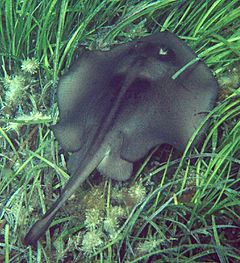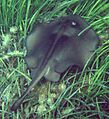Striped stingaree facts for kids
Quick facts for kids Striped stingaree |
|
|---|---|
 |
|
| Conservation status | |
| Scientific classification | |
| Kingdom: | |
| Phylum: | |
| Class: | |
| Subclass: | |
| Order: | |
| Family: |
Urolophidae
|
| Genus: |
Trygonoptera
|
| Species: |
T. ovalis
|
| Binomial name | |
| Trygonoptera ovalis Last & M. F. Gomon, 1987
|
|
The striped stingaree (Trygonoptera ovalis) is a type of stingray. It lives in the shallow waters off southwestern Australia. This stingray can grow up to 61 centimeters (about 2 feet) long. It has an oval-shaped body that is grayish or brownish. You can often see dark, mask-like patterns around its eyes. It also has two dark spots in the middle of its body that turn into lines towards its tail.
The striped stingaree has a special tail with a leaf-shaped fin at the end. It also has a small fin and a stinging spine just before the tail fin. Its rounded body helps it move easily through rocks, reefs, and seagrass beds, which are its favorite places to live. The International Union for Conservation of Nature (IUCN) says this species is of "Least Concern." This means it is not currently in danger of disappearing.
Contents
About the Striped Stingaree
The striped stingaree was first described by scientists Peter Last and Martin Gomon in 1987. They named it ovalis because its body is oval-shaped. This name comes from the Latin word for "oval." Other names for this stingray include bight stingaree and oval stingaree.
Where They Live and What They Like
The striped stingaree lives only along the coast of Western Australia. You can find them from Eucla to the Houtman Abrolhos islands. They live in waters that are 1 to 43 meters (about 3 to 140 feet) deep.
These stingrays are common and live on the bottom of the ocean. They really like rocky areas and reefs, especially where there are beds of seagrass. Sometimes, they are also seen over sand near beaches.
What Does a Striped Stingaree Look Like?
The striped stingaree has a very distinct oval body shape. Its body is a bit longer than it is wide. The front part of its body narrows down to a rounded snout.
Right behind its medium-sized eyes are comma-shaped holes called spiracles. These help the stingray breathe. Its nostrils have large flaps on the outside. Between the nostrils, there is a curtain of skin with long fringes. This hangs over its small mouth. Inside its mouth, there are many small bumps on the lower jaw and four tiny bumps on the floor of the mouth. Its small teeth have oval bases. It also has five pairs of short gill slits.
Its tail is about as long as its body. It is oval-shaped and ends in a large, deep, leaf-shaped caudal fin. On the top of its tail, there is a stinging spine with jagged edges. Just before this spine, there is a small dorsal fin. The skin of the striped stingaree is completely smooth.
The color of this stingray is special. It has a grayish to grayish-brown body. Around its eyes, there is a dark, mask-like pattern. This pattern can sometimes reach the tip of its snout, especially in younger stingrays. It also has two dark spots in the middle of its body. These spots stretch backward into stripes that go onto its tail. The area between these stripes is lighter. Sometimes, these dark markings can be hard to see. The underside of the stingray is pale, with dark edges on its fins. The tail fin is gray or black with a darker edge. The biggest striped stingaree ever found was 61 centimeters (about 2 feet) long.
Life and Habits
The striped stingaree's smooth, rounded, and flexible body helps it move very well. It can dart easily through complicated areas like rocky places and thick seagrass. This is something many other rays cannot do as easily.
It often hides under patches of seagrass. However, it has also been seen resting out in the open or buried in the sand. Scientists do not know much about its daily life. Like other stingrays, it is thought to give birth to live young. Male striped stingarees become old enough to reproduce when they are about 35 centimeters (about 14 inches) long.
Striped Stingaree and Humans
The International Union for Conservation of Nature (IUCN) has listed the striped stingaree as "Least Concern." This means it is not currently at high risk. Only a few of these stingrays are accidentally caught by fishing boats that look for scallops and prawns. This is because the striped stingaree prefers to live in rough, rocky areas where fishing nets usually do not go. The stingray could benefit from a plan made in 2004 by Australia to help protect sharks and rays.
Images for kids



